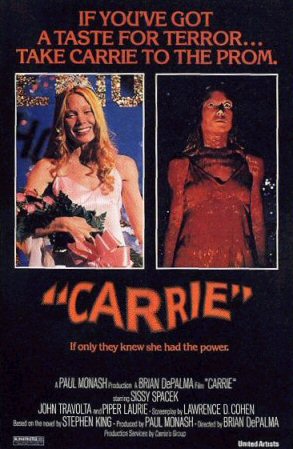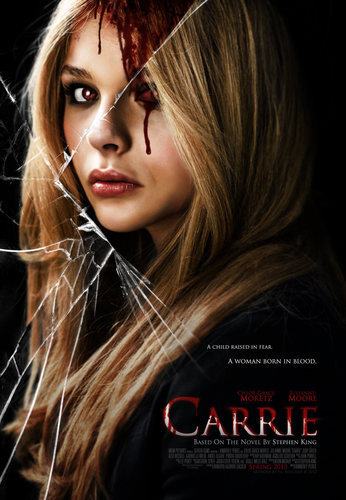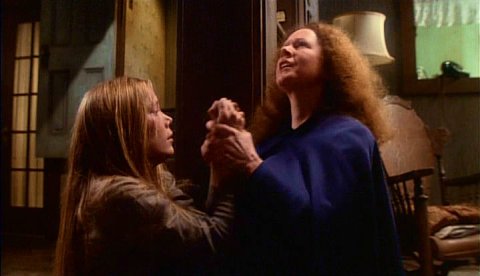October Fright Fest: Carrie (1976) and Carrie (2013)
Halloween may be one day, but I celebrate the entire month of October by watching as many horror movies as possible. Forsaking other genres for spooky, scary thrills, and filling the month with films I haven’t seen or haven’t seen in a while. So let’s grab some popcorn, turn off the lights, and get our fright on with Carrie (1976) and Carrie (2013)!
A good remake honors the spirit of the original while infusing modern sensibilities and updating the material for audiences. A good example of this is John Carpenter’s The Thing (1982). The story followed the foundation of the original novella, Who Goes There? by John W. Campbell (1938), and the Howard Hawks film, The Thing from Another World (1951). With contemporary special effects, a great cast, and suspenseful tone and atmosphere, Carpenter took the original material, infused it with his viewpoint, and created a film that was unique and not a copy of the original. While director Kimberly Peirce tries to make her version of Carrie present-day by introducing smart phones and social media, Peirce doesn’t go far enough, presenting a film that is a poor imitation of the original.
Both films follow the basic plot of the source material, Stephen King’s 1974 novel. Carrie White has her first period in the school’s showers after gym class and gets taunted by her classmates. Her first period ushers forth her telekinetic powers. Tommy asks the shy Carrie to the prom. After being the victim of a horrible prank, Carrie unleashes her vengeance.
One of the biggest differences between the two films is the portrayal of Carrie’s mother, Margaret. In the new version, the film starts with Margaret (Julianne Moore) giving birth at home. She thinks she has cancer and is surprised to have a baby. She contemplates killing the child, but changes her mind when the baby looks at her. From the start we know Margaret is confused about how her body works and that she has an extreme interpretation of Christianity. In the original, the film starts with Carrie in gym class. She is shy, awkward, and not very athletic. When she thinks she is bleeding to death in the shower, a mystery is created: how can a girl who is a senior in high school not know about the menstrual cycle? What type of environment does she live in? The first time we see 1976 Margaret (Piper Laurie), she smiles while spreading the word of the Lord. Sure, she is very religious, but we don’t know how bad the situation is until we see inside the White home and Margaret hits Carrie with a book, forcing her to quote passages, eventually shoving her into a closet to pray. Moore’s Margaret has straggly hair and a blank expression that doesn’t change much during the film. Laurie’s Margaret has vibrancy to her fervor. When she attacks Carrie, Laurie understands Margaret is an ardent follower of the Lord and convincingly transforms Margaret from stern mother into a woman wielding a knife that she believes is guided by the hand of God. The threat to Carrie’s life is real and Carrie knows there is only one way to stop her mother.
Sue Snell has a larger role in the new Carrie, with more scenes with her and Tommy and with her and Chris. Giving Sue (Gabriella Wilde) more to do detracts from Carrie. This is Carrie’s story. The need to elevate Sue into more of a sympathetic character divides the audience’s attention. We only need to care about Carrie. Also, we don’t need more time with Chris (Portia Doubleday) either. The scene when the gym teacher (Judy Greer) blackmails Chris in front of her father and the principal is unnecessary. De Palma knew the right amount of time to spend with Sue (Amy Irving) to show how guilty she felt and with Chris (Nancy Allen) to reveal how conniving and spiteful she is. By keeping the focus on Carrie, De Palma’s film moves at a better pace. Both films take about an hour to get to the prom, but Peirce’s insistence to dwell on supporting characters stops the momentum of the film.
The film is called Carrie, so the actor playing the title role has to carry the film. Chloe Grace Moretz does fine in the role, but unfortunately she brings too much energy to scenes during the first part of the film. Sissy Spacek’s performance was subtle. Spacek knew when to suck the energy out of a scene since Carrie wasn’t liked because she brought the whole room down. During the scene in English class, you forget Carrie is there even though Spacek is in the shot, so you’re just as surprised as the class when she speaks. At the prom, when Carrie finally feels comfortable enough to dance, she glows. Spacek’s smile fills the room and you feel her joy. When that bucket dumps the blood on Carrie, the combination of De Palma’s choice to only have the sound of the dripping blood and the change in Spacek’s face and body puts us on Carrie’s side. We not only understand her actions, we want her to unleash retribution.
The section the new film gets right is amping up the violence of Carrie’s punishment on those she thinks deserve it. There’s more blood and death, and Carrie stopping the car with her mind, as though the car smashes against an invisible wall, is effective. But that one section doesn’t save the remake. Peirce tried to incorporate social media, but the use of cell phones and social media doesn’t go far enough. With Twitter, YouTube, Facebook, etc., the incident in the shower would have drawn more attention. Also, the gym teacher’s actions don’t incur the consequences they should. In 1979, a teacher cursing during class and smacking a student could be swept away, but not in 2013. Now, the gym teacher would be suspended, if not fired. There would be a lawsuit and press. By not bringing this version of Carrie completely into the present, the film becomes a pale imitation of De Palma’s classic, even using many of the same lines from the 1976 film. Without a new interpretation of the material, 2013’s Carrie becomes another in a long list of unnecessary remakes.




